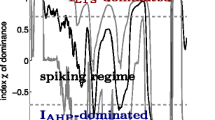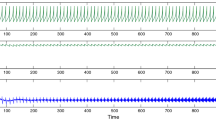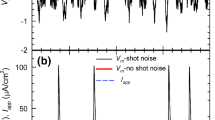Abstract
We assessed on Monte-Carlo simulated excitatory post-synaptic currents the ability of autoregressive (AR)-model fitting to evaluate their fluctuations. AR-model fitting consists of a linear filter describing the process that generates the fluctuations when driven with a white noise. Its fluctuations provide a filtered version of the signal and have a spectral density depending on the properties of the linear filter. When the spectra of the non-stationary fluctuations of excitatory post-synaptic currents were estimated by fitting AR-models to the segments of current fluctuations, assumed to be stationary and independent, the parameter and spectral estimates were scattered. The scatter was much reduced if the time-variant AR-models were fitted using stochastic adaptive estimators (Kalman, recursive least squares and least mean squares). The ability of time-variant AR-models to accurately fit the current fluctuations was monitored by comparing the fluctuations with predicted fluctuations, and by evaluating the model-learning rate. The median frequency of current fluctuations, which could be rapidly tracked and estimated from the individual quantal events (either Monte-Carlo simulated or recorded from pyramidal neurons of rat hippocampus), rose during the rise phase, before declining to a lower steady-state level during the decay phase of quantal event, whereas the variance showed a broad peak. The closing rate of AMPA channels directly affects the steady-state median frequency, whereas the transient peak can be modulated by a variety of factors—number of molecules released, ability of glutamate molecules to re-enter the synaptic cleft, diffusion constant of glutamate in the cleft and opening rate of AMPA channels. In each case, the effect on the amplitude and decay time of mEPSCs and on the current fluctuations differs. Each factor thus leaves its own kinetic fingerprint arguing that the contribution of such factors can be inferred from the combined kinetic properties of individual mEPSCs.
Similar content being viewed by others
References
Aristizabal F, Glavinović MI (2003) Wavelet analysis of Monte-Carlo simulated excitatory pots-synaptic currents. Biophys J 85: 2170–2185
Arnold M, Miltner H, Witte H, Bauer R, Braun C (1998) Adaptive AR-modeling of nonstationary time series by means of Kalman filtering. IEEE Trans Biomed Eng 45: 553–562
Benke TA, Luthi A, Palmer MJ, Wikstrom MA, Anderson WW, Isaac JTR, Collingridge GL (2001) Mathematical modeling of non-stationary fluctuation analysis for studying channel properties of synaptic AMPA receptors. J Physiol 537: 407–420
Clements JD (1996) Transmitter time course in the synaptic cleft: its role in central synaptic function. Trends Neurosci 19: 163–171
Colquhoun D, Jonas P, Sakmann B (1992) Action of brief pulses of glutamate on AMPA/kainate receptors in patches from different neurones of rat hippocampal slices. J Physiol Lond 458: 261– 287
Cory SM, Glavinović MI (2006) Molecular dynamics simulations of glutamate diffusion in synaptic cleft. Crit Rev Neurobiol 18: 47–55
DeFreitas JFG, Niranjan M, Gee AH (1998) Hierarchical Bayesian- Kalman models for regularisation and ARD in sequential learning. Tech Report CUED/F-INFENG/TR 307, Dept Eng, Cambridge Univ, UK
Derksen HE, Verveen A (1966) Fluctuations of resting neural membrane potential. Science 151: 1388–1389
Dingledine R (eds) (1984) Brain slices. Plenum, New York
Fishman HM (1973) Relaxation spectra of potassium channel noise from squid axon membranes. Proc Natl Acad Sci USA 70: 876–879
Franks KM, Stevens CF, Sejnowski TJ (2003) Independent sources of quantal variability at single glutamatergic synapses. J Neurosci. 23: 3186–3195
Glavinović MI, Rabie H (1998) Monte-Carlo simulation of spontaneous miniature excitatory postsynaptic currents in rat hippocampal synapse in the presence and in the absence of desensitization. Pflugers Arch 435: 193–202
Glavinović MI (1999) Monte-Carlo simulation of vesicular release, spatio-temporal distribution of glutamate in synaptic cleft, and generation of postsynaptic currents. Pflugers Arch 437: 462–470
Glavinović MI (2002) Mechanisms shaping fast excitatory postsynaptic currents in the central nervous system. Neural Comp 14: 1–19
Grenier Y (1983) Time-dependent ARMA modeling of non-stationary signals. IEEE Trans Acoust Speech Signal Process 31: 899–911
Haykin S (1986) Adaptive filter theory. Prentice Hall, Englewood Cliffs
Hirasawa H, Shiells R, Yamada M (2001) Blocking AMPA receptor desensitization prolongs spontaneous EPSC decay times and depolarizes H1 horizontal cells in carp retinal slices. Neurosci Res 40: 217–225
Isaacson JS, Nicoll RA (1991) Aniracetam reduces glutamate receptor desensitization and lows the decay of fast excitatory synaptic currents in the hippocampus. Proc Natl Acad Sci USA 88: 10936–10940
Isaksson A, Wennberg A, Zetterberg L (1981) Computer analysis of EEG signals with parametric models. Proc IEEE 69: 451–461
Jackson MF, Joo DT, Al-Mahrouki AA, Orser BA, Macdonald JF (2003) Desensitization of alpha-amino-3-hydroxy-5-methyl-4-isoxazolepropionic acid (AMPA) receptors facilitates use-dependent inhibition by pentobarbital. Mol Pharmacol 64: 395–406
Jonas P, Major G, Sakmann B (1993) Quantal components of unitary EPSCs at the mossy fibre synapse on CA3 pyramidal cells of rat hippocampus. J Physiol Lond 472: 615–663
Jones MV, Westbrook GL (1996) The impact of receptor desensitization on fast synaptic transmission. Trends Neurosci 19: 96–101
Kaipio J, Karjalainen P (1997) Simulation of nonstationary EEG. Biol Cybern 76: 349–356
Kalman R (1960) A new approach to linear filtering and prediction problems. Trans ASME J Basic Eng 82: 35–45
Katz B, Thesleff S (1957) A study of the desensitization produced by acetylcholine at the motor end-plate. J Physiol Lond 138: 63–80
Katz B, Miledi R (1972) The statistical nature of the acetycholine potential and its molecular components. J Physiol Lond 224: 665–699
Kleinle J, Vogt K, Luscher HR, Muller L, Senn W, Wyler K, Streit J (1996) Transmitter concentration profiles in the synaptic cleft: an analytical model of release and diffusion. Biophys J 71: 2413–2426
Krnjević K, Glavinović MI (1999) Use of parametric analysis to evaluate number and kinetics of post-synaptic receptors. Soc Neurosci Abstr 25: 992
Kruk PJ, Korn H, Faber DS (1997) The effects of geometrical parameters on synaptic transmission: a Monte-Carlo simulation study. Biophys J 73: 2874–2890
Longsworth LG (1953) 25°C, of aqueous solutions of amino acids, peptides and sugars. J Amer Chem Soc 75: 5705–5709
Marmarelis PZ, Marmarelis VZ (1978) Analysis of physiological systems. Plenum, New York
Mozrzymas JW (2004) Dynamism of GABA(A) receptor activation shapes the “personality” of inhibitory synapses. Neuropharmacology 47: 945–960
Nielsen TA, DiGregorio DA, Silver RA (2004) Modulation of glutamate mobility reveals the mechanism underlying slow-rising AMPAR EPSCs and the diffusion coefficient in the synaptic cleft. Neuron 42: 757–771
Pardey J, Roberts S, Tarassenko L (1996) A review of parametric modeling techniques for EEG analysis. Med Eng Phys 18: 2–11
Penny WD, Roberts SJ (1999) Dynamic models for nonstationary signal segmentation. Comp Biomed Res 32: 483–502
Rao TS (1970) The fitting of non-stationary time series models with time dependent parameters. J R Stat Soc B 32: 312–322
Rioul O, Vetterli M (1991) Wavelets and signal processing. IEEE Sig Proc 8: 14–38
Robinson HPC, Sahara Y, Kawai N (1991) Nonstationary fluctuation analysis and direct resolution of single channel currents at postsynaptic sites. Biophys J 59: 295–304
Sakmann B, Patlak J, Neher E (1980) Single acetylcholine-activated channels show burst-kinetics in presence of desensitizing concentrations of agonist. Nature 286: 71–73
Sayed A, Kailath T (1994) State-space approach to adaptive RLS filtering. IEEE Signal Process Mag 11: 18–60
Schlogl A (2000) The electroencephalogram and the adaptive autoregressive model: theory and applications. PhD dissertation, Dept. Med. Informatics, Inst Biomed Eng Univ Technol Graz, Austria
Silberberg SD, Magleby KL (1993) Preventing errors when estimating single channel properties from the analysis of current fluctuations. Biophys J 65: 1570–1584
Tarvainen MP, Hiltunen JK, Ranta-aho PO, Karjalainen PA (2004) Estimation of nonstationary EEG with kalman smoother approach: an application to event-related synchronization (ERS). IEEE Trans Biomed Eng 51: 516–524
Traynelis SF, Jaramillo F (1998) Getting the most out of noise in the central nervous system. Trends Neurosci 21: 137–145
Trussell LO, Fischbach GD (1989) Glutamate receptor desensitization and its role in synaptic transmission. Neuron 3: 209–218
Ventriglia F (2004) Saturation in excitatory synapses of hippocampus investigated by computer simulations. Biol Cybern 90: 349–59
Wahl LM, Pouzat C, Stratford KJ (1996) Monte-Carlo simulation of fast excitatory synaptic transmission at a hippocampal synapse. J Neurophysiol 75: 597–608
Wall MJ, Robert A, Howe JR, Usowicz MM (2002) The speeding of EPSC kinetics during maturation of a central synapse. Eur J Neurosci 15: 785–797
Welch G, Bishop G (2002) An introduction to the Kalman filter. Tech. Report TR 95-041. Dept Comp Sci, Univ North Carolina at Chapel Hill. http://www.cs.unc.edu/~welch
Yelshansky MV, Sobolevsky AI, Jatzke C, Wollmuth LP (2004) Block of AMPA receptor desensitization by a point mutation outside the ligand-binding domain. J Neurosci 24: 4728–4736
Author information
Authors and Affiliations
Corresponding author
Rights and permissions
About this article
Cite this article
Glavinović, M.I., Gooria, P., Aristizabal, F. et al. Parametric spectral analysis of nonstationary fluctuations of excitatory synaptic currents. Biol Cybern 98, 145–169 (2008). https://doi.org/10.1007/s00422-007-0200-2
Received:
Accepted:
Published:
Issue Date:
DOI: https://doi.org/10.1007/s00422-007-0200-2




